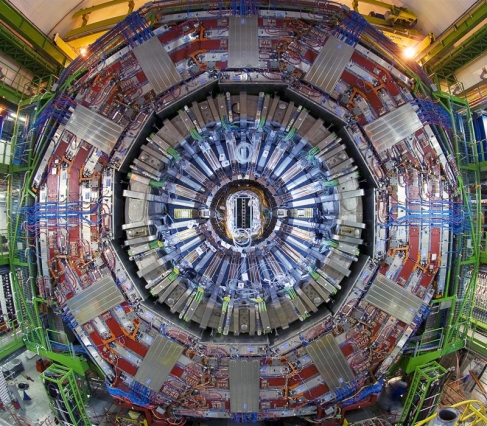The new particle whose discovery was announced by the Director of European Centre for Nuclear Research (CERN) in Geneva on July 4, 2012 opened up a newera in the field of science. When the announcement was made that there is convincing evidence for the long sought-after “Higgs Boson” particle, all the news channels and websites started flashing it as breaking news. Most of them cited it as “GOD Particle”. The nickname “GOD Particle” originated from a book by the Nobel laureate Leon Lederman. He actually wanted to call the Higgs Boson the “Goddamn particle” because it’s so darned difficult to find.
Experimental high-energy physics around the world began the hunt for the particle in 1990’s when high energy accelerators came on the scene, beginning with the Large Electron Positron Collider (LEP) at CERN, but were unsuccessful so far. After 22 years, in 2012, a new particle has shown up at the Large Hadron Collider (LHC), which took the place of LEP in the underground tunnel 27km in the circumference. Then there were some questions: if it is really the Higgs Boson an important chapter in high energy nuclear physics? What is Higgs particle and why was it so important to find it? Are we close to understand the universe with this new discovery?
The existence of the Higgs Boson is predicted by a highly successful theoretical framework called the Standard Model of particle physics, which describes the subatomic world of elementary particles and the fundamental forces of interactions among them,except gravity. But the other particles cannot have mass without the Higgs Boson. The Higgs Boson is the particle manifestation of a force field that is included in the theory as a quantum mechanical concept to provide mass of the particles. So if the theory is to describe the real universe, the Higgs Boson has to be found and understand. The particle is called Boson because it has zero value of spin.
It is important to know that the model itself does not predict a value for the mass of the Higgs.Rather there are indirect constraints on the Higgs mass from other theoretical and phenomenological considerations which constrain its mass to be less than 160-180 Giga electron volt (GeV).
On July 2, just two days before CERN announced its landmark results in its search for the Higgs Boson, the United States- based Fermi National Accelerator Laboratory (Fermilab) announced the final results of its own hunt for the elusive particle at the Tevatron Collider. The scientists announced that if the Higgs particle exists, it has a mass between 115 GeV and 135 GeV. The two methods employed at Fermilab and CERN to create the Higgs Boson were quitesimilar; both accelerate particles to high energies and smash them head-on to create other particles, in particular the Higgs Boson. At CERN, the LHC accelerates two counter rotating proton beams with energy of 4 TeV (tera electron volt) each, thus providing 8TeV of total collision energy to create new particles. At the Tevatron, counter rotating beams of protons and antiprotons were being accelerated to 1 TeV each, which means 2 TeV of total collision energy.
The process involves the annihilation of a quark and an antiquark from the proton and antiproton respectively to produce a W boson.W boson is one of the carriers of the weak nuclear force. This heavy W- boson has a chance to create a Higgs boson from the extra energy it has. The W boson and Higgs boson would then decay into other particles that are detected by the detectors and then identified.
However, what is remarkable is that two independent detectors set up at the LHC- The Compact Muon Solenoid (CMS) and the A Toroidal LHC Apparatus (ATLAS) as well as detectors at Tevatron have led to the same conclusion that “a new boson of about 125 GeV has been discovered”.It has been said by the one of the member of the ATLAS collaboration that “there is full consistency between the LHC and Tevatron findings”.
Ten important points about the Higgs Boson are as follows:
- The term “Boson” comes from the name of Indian physicist and mathematician “Satyendra Nath Bose”.
- “Peter Higgs” best known paper on the new particle was initially rejected.
- The existence of the Higgs Boson is predicted by a highly successful framework called the Standard model of particle physics.
- Higgs decays into a bottom quark (b) and an anti-bottom quark (anti-b).
- The particle is a Boson because it has zero value for the quantum attribute of particles called ‘spin’.
- The lifetime of Higgs itself is very short (10-22 second).
- The massof Higgs lies between 115 GeV and 135 GeV (giga electron volt).
- The United Kingdom Science Minister “William Waldegrave” in 1993 once held a national competition to find the best Higgs explanation
- Higgs is difficult to explain without the theory of supersymmetry.
- Finding the new particle would give physicists a whole new set of mysteries to explore.
